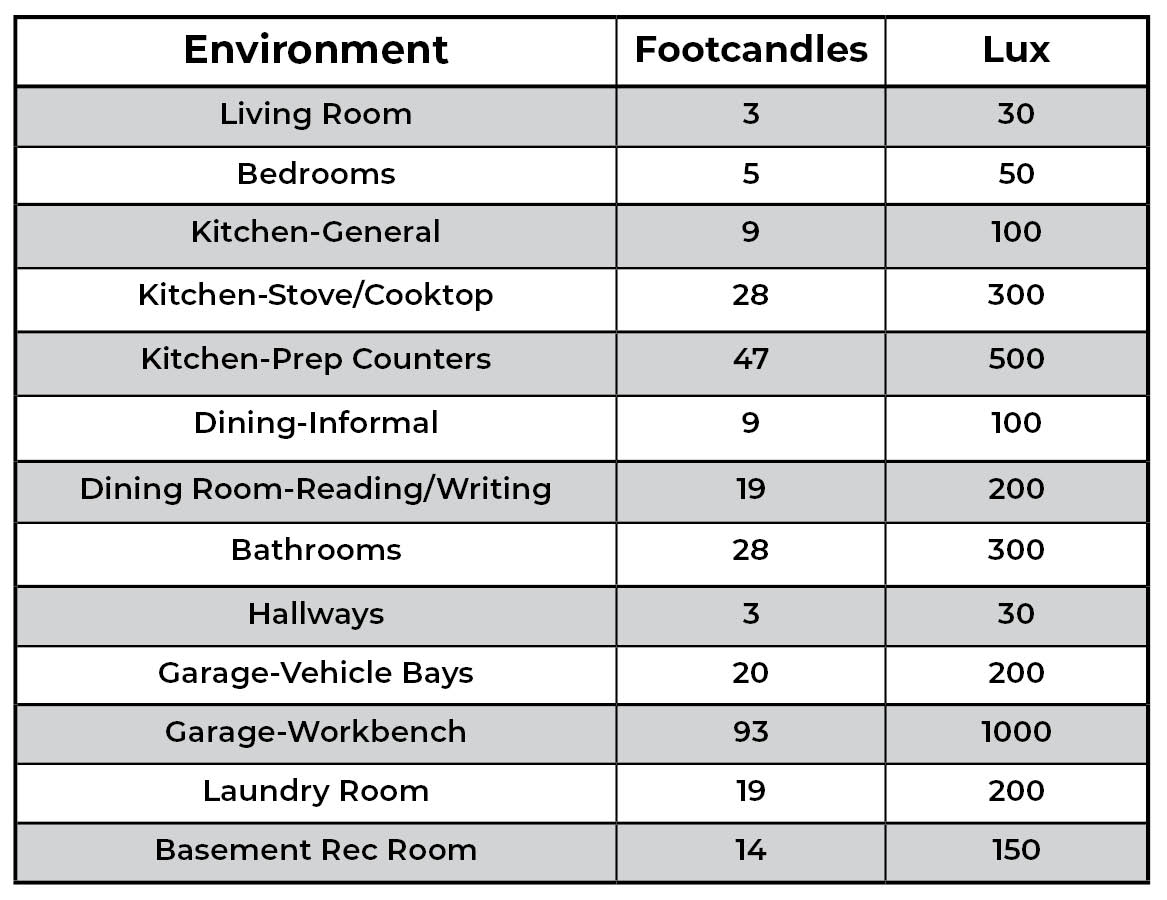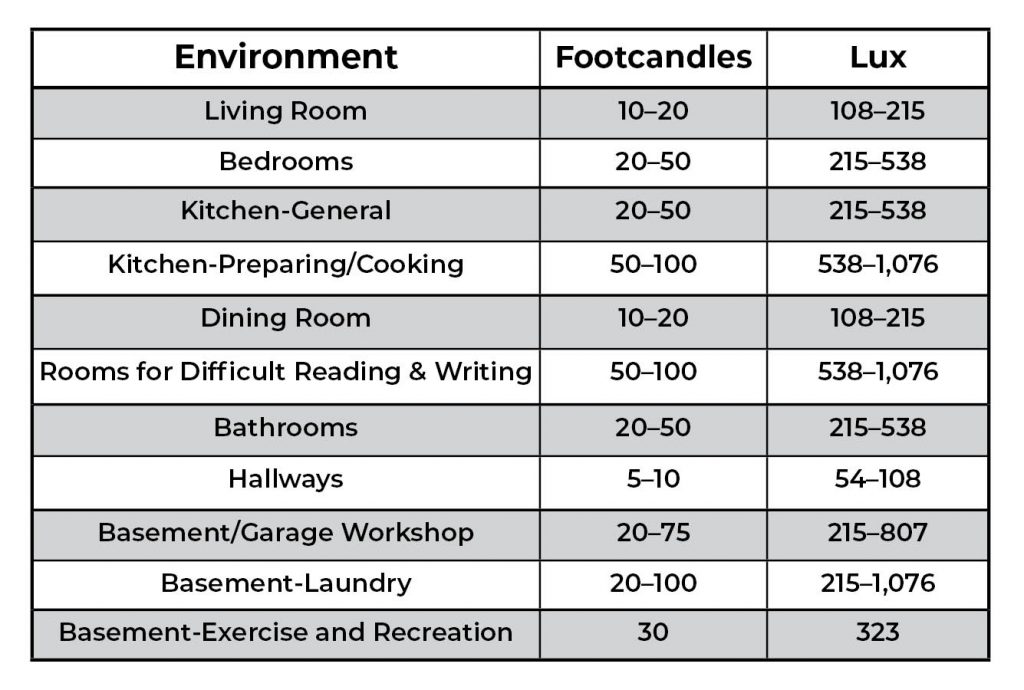If you’re renovating your current home, building a new one, or just curious how you can optimize lighting, you might be wondering how many lights you need in each room. Sure, you could guess and end up overlighting or underlighting your home, but did you know that there are actually set recommendations for how much light should be in different types of rooms? These recommendations are given by lighting designers, engineers, architects, and the Illuminating Engineering Society (IES), and they can help you determine the right number of lights to use in different areas of your home.
As stated on their website, the IES is “. . . an accredited Standards Development Organization (SDO) under American National Standards Institute (ANSI) approved procedures.” They work to inform the public of best practices for using lighting to meet visual and aesthetic needs. The organization consists of different types of lighting professionals who are all working toward quality lighting design for every space.
The way in which the IES and other lighting professionals communicate how much light should be used in a space is to give lux or foot-candle recommendations. Both of these are measurements for how much light makes it onto a surface. Lux means lumens per square meter, and foot-candles means lumens per square foot. Lumens are a measurement that describes the amount of light produced from a light source. There are two separate tables shown below: Table A has strictly IES recommendations, and Table B combines recommendations from the IES as well as architects and engineers.
Table A: IES recommended lighting levels

Table B: Combination of lighting recommendations

You’ll notice that the IES’ recommendations are lower than the numbers in Table B. The suggestions given from the IES are minimum light levels for a usable space. Table B takes into account the different purposes of certain spaces. It gives a broader range that allows for differing factors that affect lighting from home to home. It’s easier to meet these recommendations with an LED light fixture. Unlike ceiling fixtures with 360-degree incandescent bulbs, LED alternatives have tighter beam angles, so more light makes it to surfaces and the floor. This means that you’ll need fewer fixtures, but roughly how many lumens do you need? There are a couple ways to find out.
Option 1: Use a simple formula
To get an idea of what lumen output you should have for each room, you can use this formula, which is based on an 8-foot ceiling height. It’s a great starting point but does not account for beam angles or reflectivity of ceilings and walls, so you might need to tweak it a bit depending on your space and its design.
Room square footage x suggested foot-candles for that type of room = lumens needed
*Calculate a room’s square footage by multiplying its length by its width.
For example, a bedroom that is 12′ long by 14′ wide has a square footage of 168. If you wanted to use the IES’ recommended light level for a bedroom, you’d multiply 168 by 5 foot-candles (168 x 5 = 840), and you’d see that the bedroom requires 840 lumens for general use. This amount of lumens is equivalent to about one traditional 60-watt incandescent bulb or a 10-watt A19 LED bulb. This output might be perfect for a guest bedroom that’s used only for sleeping and dressing.
A teenager’s bedroom, on the other hand, would need more light if it’s used for schoolwork. If you use the minimum of 20 foot-candles shown for bedrooms on Table B, you’d need 3,360 lumens (168 x 20 = 3,360) for a 12-by-14-foot space. This equates to about four 60-watt or 60-watt-equivalent A19 bulbs. This number doesn’t specify where those lumens should come from—just that it’s a good amount of light to have total. It could come from a combination of lamps, desk lights, and ceiling lights.
Option 2: Use another room’s light level as inspiration
Another method for determining how many lumens you need is to use a light meter. When placed on a surface, it will tell you how much light that surface is receiving in foot-candles or lux (depending on the type of light meter you’re using). If you do this in a room where you’re satisfied with the lighting, the light meter will help you match it. You can use the formula above to figure out how many lumens you need; just multiply your room’s square footage by the foot-candle value you got from the light meter. Keep in mind that light gets dimmer the farther away it is from the source. So if you’re measuring a spot directly underneath a light and want that level everywhere, you’ll most likely have to add more lights.
Considerations and other options
These methods are great for getting an idea of what to shoot for when it comes to how much light your home needs. And in the midst of building or renovating a house, it’s nice to have a plan and one less thing to wonder or worry about. Option one is a perfect starting point, but those numbers are, however, just guidelines. The level of light that you like might not be in either of the tables shown above. When it comes down to it, residential lighting is all about personal preference. Different homes will require different levels of light based on room size, wall color, ceiling height, room purpose, glare, lamp shades, and other factors.
If you’re unsure about if you’ll like the output found in the tables or if you have no room to copy output from with a light meter, stick with one of the lower recommendations or IES suggestions. You can always add supplemental lighting, such as lamps or under-cabinet lights. Another option is to buy brighter lights than you think are necessary and install dimmers. There are several options that can help you through this process. Now that you know determining how much light is in a space doesn’t have to be a shot in the dark, you just have to choose which method works for you.
led lights,solar lights,led strip lights,outdoor stores,WIFI Deck Lights,WIFI LED Strip
